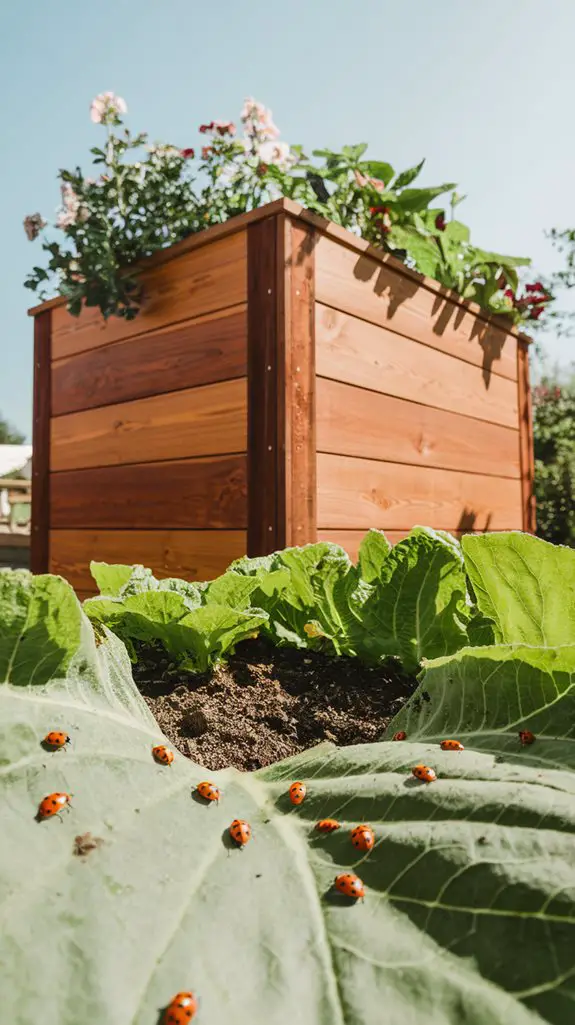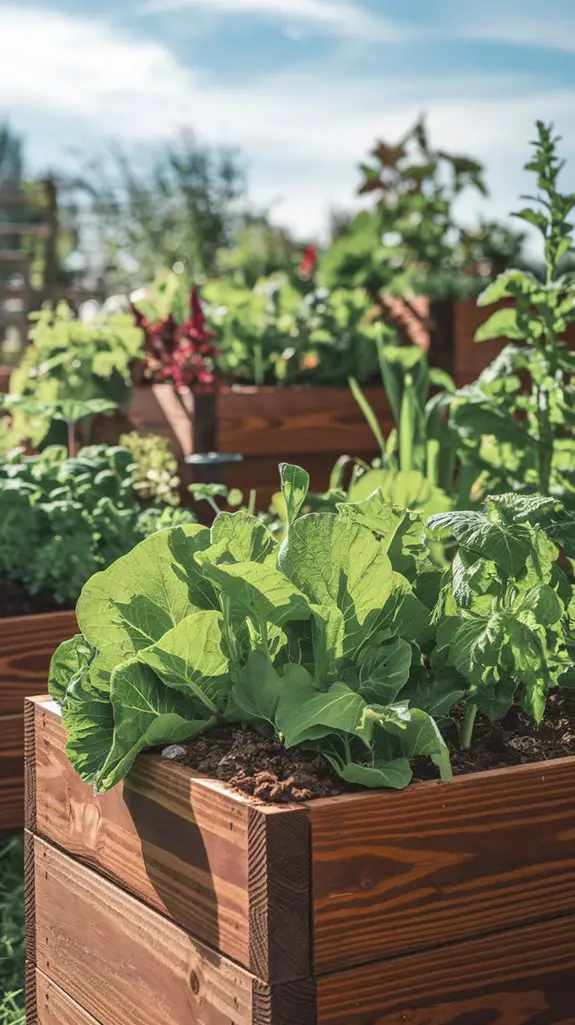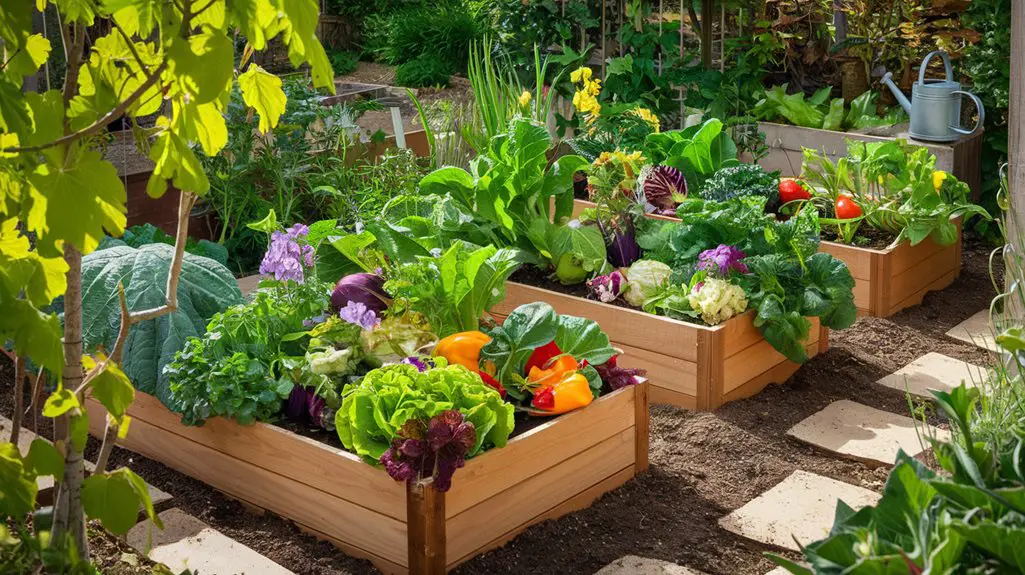Many gardeners overlook the significant advantages of raised garden beds, which can transform your gardening experience. These structures not only improve soil drainage but also allow for tailored soil compositions that enhance nutrient retention. With less pest access and easier maintenance, they cater to both seasoned and novice gardeners. If you're curious about how these beds can optimize your gardening efforts and provide additional benefits, consider the various factors that make them a worthwhile investment.
Improved Soil Drainage
When you choose raised garden beds, you'll likely notice significant improvements in soil drainage compared to traditional in-ground gardens. The elevated structure allows rainwater to flow freely, preventing water from pooling around plant roots. This is vital, as excess moisture can lead to root rot and other diseases. Furthermore, since raised beds are often filled with a well-draining soil mix, they promote better aeration, ensuring that plant roots have access to necessary oxygen. You'll also find that the soil warms up faster in the spring, allowing for earlier planting. In addition, if you experience heavy rainfall, the raised design minimizes soil erosion, preserving your garden's integrity. Ultimately, improved drainage creates a healthier environment for your plants to thrive, as better aeration contributes significantly to overall plant health.
Enhanced Soil Quality
Raised garden beds not only improve drainage but also greatly enhance soil quality. By controlling the soil composition, you can create an ideal environment for plant growth. You'll notice that raised beds allow for better aeration and nutrient retention, leading to healthier plants. Additionally, raised beds can help to reduce soil compaction, which is a common issue in traditional gardening. Here's a quick comparison of soil qualities in raised beds versus traditional gardens:
| Feature | Raised Garden Beds | Traditional Gardens |
|---|---|---|
| Soil Composition | Customizable | Limited |
| Aeration | Improved | Variable |
| Drainage | Excellent | Often Poor |
| Nutrient Retention | High | Moderate |
| Root Health | Enhanced | Compacted |
Reduced Pest Problems

While pests can be a gardener's worst nightmare, using raised garden beds greatly reduces their presence and impact. These beds elevate your plants, making it harder for certain pests, like slugs and snails, to reach them.
Additionally, the soil in raised beds often drains better, reducing excess moisture that attracts pests. You can also easily incorporate barriers—such as mesh or fabric—to further shield your crops.
The controlled environment of a raised garden bed allows for better plant selection, letting you choose pest-resistant varieties. Furthermore, by managing your bed's soil and structure, you can create a habitat that encourages beneficial insects, which prey on harmful pests. Incorporating effective pest control measures tailored to raised beds can enhance your gardening success.
Ultimately, raised garden beds offer a strategic advantage in pest management.
Easier Access for Gardening
Since raised garden beds are elevated off the ground, they provide easier access for gardeners of all ages and abilities.
This design minimizes the need to bend or kneel, making it especially beneficial for those with mobility issues or back pain. You can easily reach plants without straining, allowing for more comfortable planting, weeding, and harvesting.
Additionally, the height can be adjusted to suit your preferences, whether you want a standard or a more accessible height. This convenience also encourages engagement with gardening, as you're less likely to feel overwhelmed by physical strain.
Raised garden beds also allow for vertical gardening, which can maximize your growing space and improve overall plant health.
Ultimately, raised garden beds create a more enjoyable gardening experience, enabling you to focus on nurturing your plants rather than enduring discomfort.
Extended Growing Season

One of the significant advantages of raised garden beds is their ability to extend the growing season for your plants. The elevated soil warms up faster in spring, allowing you to plant earlier than in traditional gardens. This temperature advantage promotes root development and plant health, setting the stage for a more fruitful yield.
Additionally, raised beds drain better, reducing the risk of waterlogging that can delay growth. You can also cover them easily with protective materials, like row covers, to shield your plants from unexpected frosts or harsh weather. Furthermore, using recycled materials to build your raised beds can enhance their sustainability while minimizing waste.
Better Weed Control
Raised garden beds offer a practical solution for managing weeds more effectively, allowing you to focus on nurturing your plants. By elevating your garden, you create a barrier that makes it harder for weeds to invade.
Here are three key benefits of better weed control in raised beds:
- Reduced Competition: With fewer weeds, your plants can access more nutrients, water, and light, promoting healthier growth.
- Easier Maintenance: You'll spend less time pulling weeds, giving you more time to enjoy your garden.
- Enhanced Soil Quality: Controlling weeds helps maintain soil structure and fertility, ensuring your plants thrive.
Incorporating raised garden beds not only simplifies weed management but also enhances your overall gardening experience.
Customizable Garden Design
When you choose to use raised garden beds, you gain the flexibility to design your garden layout according to your preferences and needs.
You can easily customize the size, shape, and configuration of each bed to fit your space, whether it's a small balcony or a sprawling backyard. This adaptability allows you to create distinct zones for different plant types, optimizing growth conditions. Raised beds also enable you to incorporate pathways, making access to your plants more convenient. Additionally, you can choose materials that complement your outdoor space while ensuring durability. Furthermore, raised garden beds are excellent for improving soil quality and drainage, which can lead to healthier plants.
Aesthetic Appeal in the Backyard
A well-designed garden can transform your backyard into a serene retreat, and raised garden beds play a crucial role in enhancing this aesthetic appeal.
They not only provide structure but also create visual interest. Here are three ways raised garden beds elevate your outdoor space:
- Defined Spaces: By organizing your plants into raised beds, you establish clear boundaries that make your garden feel intentional and curated.
- Variety of Materials: You can choose from wood, stone, or metal, allowing you to align your garden's style with your home's architecture.
- Vertical Elements: Raised beds can be designed with trellises or decorative edges, adding height and dimension that draws the eye and invites exploration.
Additionally, raised garden beds can improve easy gardening by minimizing bending and kneeling, making it accessible for everyone.
These features make raised garden beds a fundamental element in achieving a beautiful and functional landscape.
Conclusion
To sum up, raised garden beds truly are a gardener's best friend. They not only improve soil drainage and quality but also make gardening more accessible and enjoyable. You'll find that they help keep pesky critters at bay while allowing for a more customized and aesthetically pleasing garden design. With these structures, you're not just planting seeds; you're sowing the seeds of a thriving garden that can flourish well into the season. It's a win-win for any gardening enthusiast!




